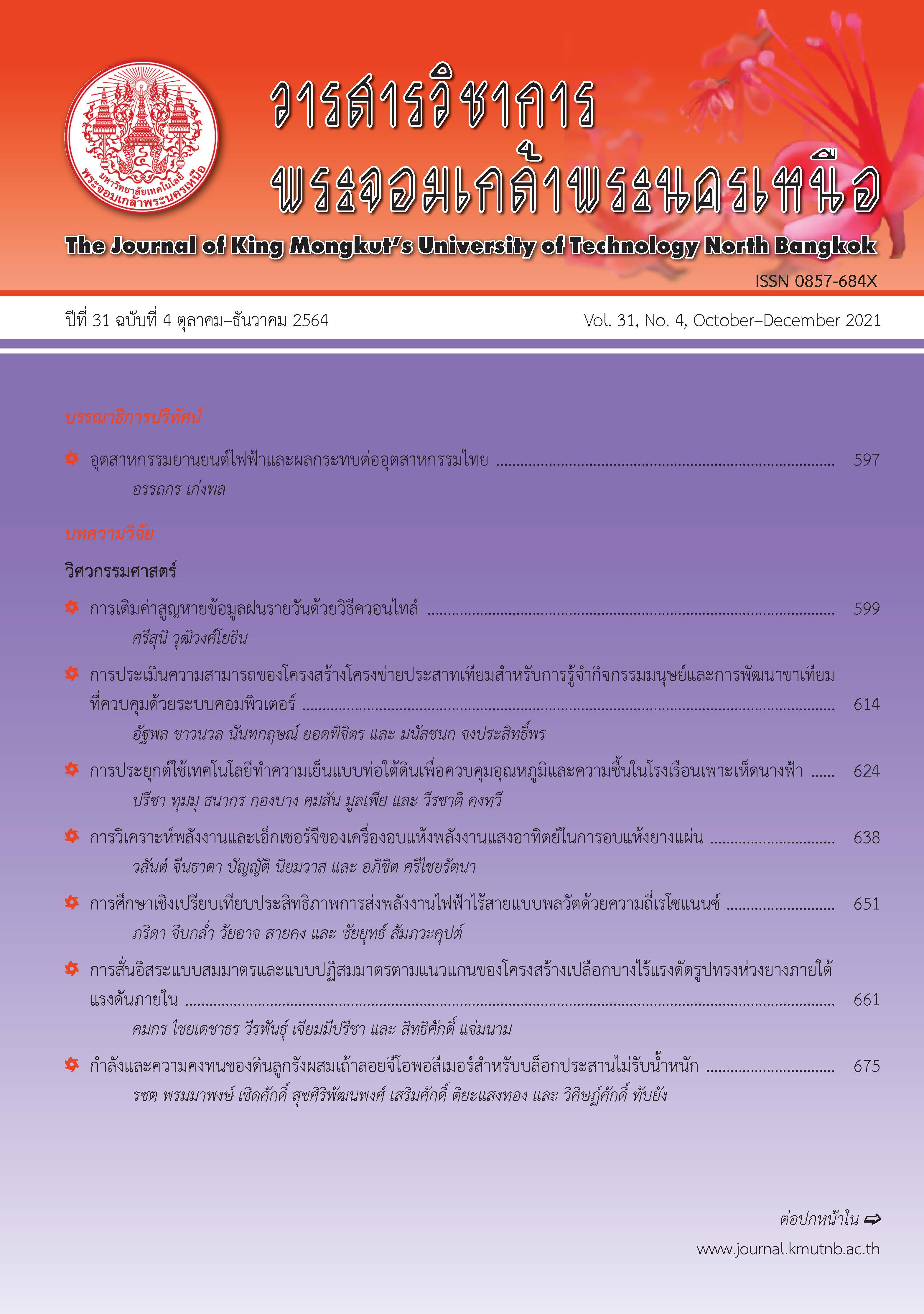การศึกษาเชิงเปรียบเทียบประสิทธิภาพการส่งพลังงานไฟฟ้าไร้สายแบบพลวัตด้วยความถี่เรโซแนนซ์
Main Article Content
บทคัดย่อ
บทความนี้นำเสนอการออกแบบระบบการส่งพลังงานไฟฟ้าไร้สายแบบพลวัตด้วยวิธีความถี่เรโซแนนซ์ โดยใช้ภาคส่งพลังงานไฟฟ้าหลายชุดขนานกับวงจรอินเวอร์เตอร์ชุดเดียวสำหรับยานยนต์ไฟฟ้าขนาดเล็ก เพื่อหาประสิทธิภาพในการส่งพลังงานไฟฟ้าไร้สายแบบพลวัตระหว่างภาคส่งพลังงานไฟฟ้าและภาครับพลังงานไฟฟ้า ทำการจำลองการถ่ายโอนพลังงานไฟฟ้าไร้สายแบบพลวัตรูปแบบวงจรเรโซแนนซ์ทั้ง 4 แบบ คือ แบบขนาน-ขนาน แบบขนาน-อนุกรม แบบอนุกรม-ขนาน และแบบอนุกรม-อนุกรม โดยปรับระยะห่างระหว่างวงจรภาคส่งพลังงานไฟฟ้าและระยะห่างระหว่างภาคส่งและภาครับพลังงานไฟฟ้าที่ความถี่เรโซแนนซ์ จากการจำลองผล พบว่า รูปแบบวงจรเรโซแนนซ์แบบอนุกรม-อนุกรมให้ประสิทธิภาพการถ่ายโอนพลังงานไฟฟ้าแบบพลวัตสูงที่สุด 18.56 เปอร์เซ็นต์ เมื่อเทียบกับแบบอื่น โดยระยะห่างที่เหมาะสมระหว่างวงจรภาคส่งพลังงานไฟฟ้าอยู่ที่ 0.04 เมตร และระหว่างวงจรภาคส่งพลังงานไฟฟ้าและภาครับพลังงานไฟฟ้าอยู่ที่ 0.15 เมตร
Article Details
บทความที่ลงตีพิมพ์เป็นข้อคิดเห็นของผู้เขียนเท่านั้น
ผู้เขียนจะต้องเป็นผู้รับผิดชอบต่อผลทางกฎหมายใดๆ ที่อาจเกิดขึ้นจากบทความนั้น
เอกสารอ้างอิง
[2] C. Panchal, S. Stegen, and J. Lu, “Review of static and dynamic wireless electric vehicle charging system,” Engineering Science and Technology, an International Journal, vol. 21, no. 5, pp. 922–937, 2018.
[3] X. Zhang, Z. Yuan, Q. Yang, Y. Li, J. Zhu, and Y. Li, “Coil design and efficiency analysis for dynamic wirelesscharging system for electric vehicles,” IEEE Transactions on Magnetics, vol. 52, no. 7, 2016.
[4] C. Anyapo, N. Teerakawanich, and C. Mitsantisuk, “Development of multi-coils full-bridge resonant inverter for dynamic wireless power transfer,” presented at the 14th International Conference on Electrical Engineering/Electronics, Computer, Telecommunications and Information Technology (ECTI-CON), Phuket, Thailand, June 27–30, 2017 (in Thai).
[5] X. Dai, J. C. Jiang, and J. Q. Wu, “Charging area determining and power enhancement method for multiexcitation unit configuration of wirelessly dynamic charging EV system,” IEEE Transactions on Industrial Electronics, vol. 66, no. 5, pp. 4086–4096, May 2019.
[6] S. Jeong, Y. J. Jang, D. Kum, and M. S. Lee, “Charging automation for electric vehicles : Is a smaller battery good for the wireless charging electric vehicles?,” IEEE Transactions on Automation Science and Engineering, vol. 16, no. 1, pp. 486–497, 2019.
[7] Z. Bi, G. A. Keoleian, Z. Lin, M. R. Moore, K. Chen, L. Song, and Z. Zhao, “Life cycle assessment and tempo-spatial optimization of deploying dynamic wireless charging technology for electric cars,” Transportation Research Part C: Emerging Technologies, vol. 100, pp. 53–67, Mar. 2019.
[8] L. Sun, D. Ma, and H. Tang, “A review of recent trends in wireless power transfer technology and its applications in electric vehicle wireless charging,” Renewable and Sustainable Energy Reviews, vol. 91, no. C, pp. 490–503, Aug. 2018.
[9] M. Debbou and F. Colet, “Inductive wireless power transfer for electric vehicle dynamic charging,” presented at the IEEE PELS Workshop on Emerging Technologies: Wireless Power Transfer (WoW), Knoxville, TN, USA, October 4–6, 2016.
[10] A. Poorfakhraei, G. Movaghar, and F. Tahami, “Optimum design of coils in a dynamic wireless electric vehicle charger with misalignment compensation capability,” presented at the 8th Power Electronics, Drive Systems & Technologies Conference (PEDSTC), Mashhad, Iran, February 14–16, 2017.
[11] S. Raju, R. Wu, M. Chan, and C. P. Yue, “Modeling of mutual coupling between planar inductors in wireless power applications,” IEEE Transactions on Power Electronics, vol. 29, no. 1, pp. 481–490, January 2014.

